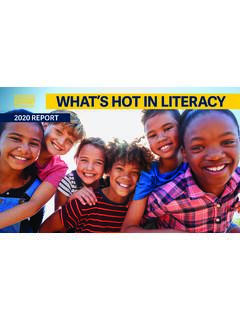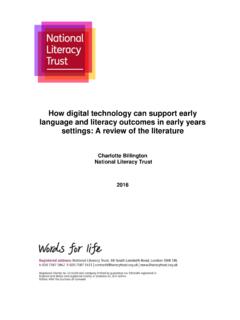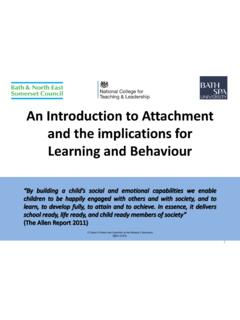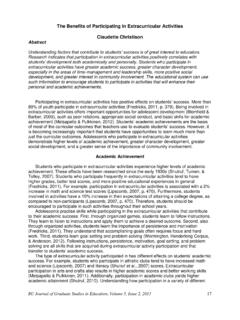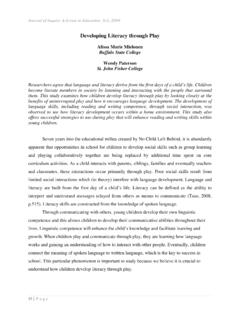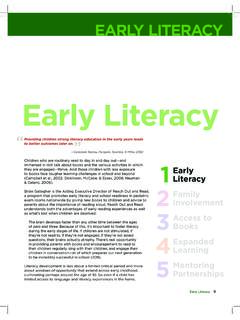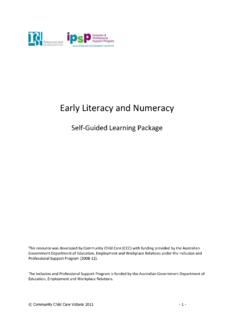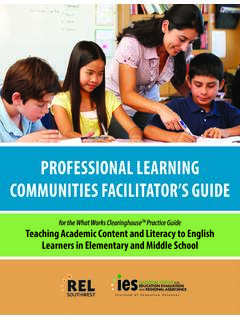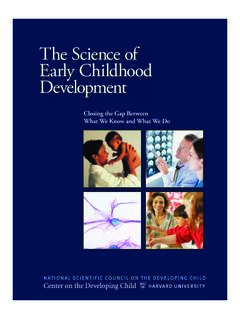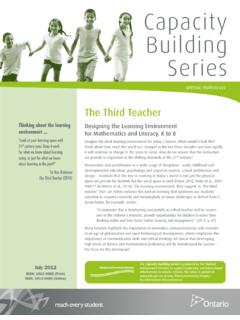Transcription of Digital Resources in Early Childhood Literacy Development
1 International Literacy Association | 2019 POSITION STATEMENT AND research BRIEFD igital Resources in Early Childhood Literacy Development2 Digital technologies are pervasive in homes, schools, and communities, yet beliefs about and recommendations for how they are used in Early Childhood vary widely. The International Literacy Association maintains that rich, Digital Resources have a place in Early Childhood Literacy Development . Careful, intentional, and developmentally appropriate use of Digital texts and tools can build young children s language and Literacy skills while providing young children with opportunities to deepen their understanding about the forms and functions of Digital text in meaning everyday lives of children growing up in Western English-speaking countries are shaped by the ubiqui-tous presence of Digital and interactive multimedia, often presented via technologies such as tablets and smartphones ( , touchscreens).
2 Digital technologies are per-vasive in homes, schools, and communities, yet beliefs about and recommendations for how they are used in Early Childhood vary widely. The prominence of so many differing views about Digital technologies in Early Childhood can lead to great confu-sion for families, educators, and policy statements from a variety of sources vary widely in terms of the following: How they define technologies Whether they include research studies informing their conclusions Whether they are connected to the Digital industryFor example, some argue that Digital technologies should have a very limited role in Early Childhood contexts, as the use of Digital technologies will come to supplant, rather than supple-ment, key learning opportunities such as hands-on experiences or social interaction ( , Campaign for a Commercial-Free Childhood , Alliance for Childhood , & Teachers Resisting Unhealthy Children s Entertainment, 2012; Cordes & Miller, 2000; Miller, 2005).
3 Given the prominence of Digital technology, others empha-size promoting healthy screen time habits and use. In 2011, for example, the American Academy of Pediatrics (AAP) advised that children under 2 years of age avoid media use. However, in 2016, the AAP revised its guidelines to account for the abun-dance of new Digital media. The AAP now emphasizes the im-portance of selecting Digital media that are developmentally 3[S]eek ing out Digital media that do not exploit children s Development or personal information data is , with high-quality content. The AAP also empha-sizes social interaction as an essential component of children s screen time, a goal that is accomplished by having adults play or view along with other policy statements convey similar recommenda-tions but go a step further, arguing that when judiciously se-lected and strategically used, Digital technologies enhance children s opportunities for learning ( , Early Childhood Australia, 2018; Lerner & Barr, 2014; National Association for the Education of Young Children & the Fred Rogers Center, 2012, Scottish Government, 2013; Department of Education & Department of Health and Human Services, 2016).
4 Common threads across these policy statements include the following: Selection of high-quality Digital media conveying content that supports curricular and learning goals and includes minimal distractors ( , ads, links that take users away from a site) Integration of Digital technologies in ways that complement and enhance learning with other essential materials and activities Use of technology that supports Development of creativity, exploration, collaboration, problem solving, and knowledge Development Use of technology to strengthen home school connections Access to assistive technologies to support equitable opportu-nities for learningThese statements consistently express concern over the quality of content and the lack of any regulation of commer-cial advertising in children s media. Because of such concerns, seeking out Digital media that do not exploit children s devel-opment or personal information data is imperative.
5 Several ef-forts have been made to address the quality and ethical delivery of such tools to young audiences, for example, the Designing for Children s Rights (Designing for Children s Rights Association, 2018) is a resource for interactive Digital media designers. Other tools to help families and educators determine quality are available from KIDMAP (Haines, 2017) and the National Association for the Education of Young Children s Selecting Apps to Support Children s Learning resource. 4[M]eaningful use of high-quality Digital Resources is essential in preparing all young children for long-term academic success. In addition, families and educators need to be vigilant about children s overall time spent with screens in the absence of so-cial interaction, or with low-quality content. Abundant warn-ing about the potential harms Digital media can cause will not by itself remediate the situation (Paciga & Donohue, 2017).
6 Integrating Digital Resources in Early Learning ContextsGrowing evidence suggests that despite reported concern about the impact of technology on attention and socialization, meaningful use of high-quality Digital Resources is essential in preparing all young children for long-term academic success. For example, meaningful use of Digital Resources yielded sig-nificantly greater benefit to important Literacy outcomes for young children than use of traditional Resources only (Cviko, McKenney, & Voogt, 2012, 2013) and diminished substantially the language and Literacy differences between children from high- and low-poverty backgrounds (Neuman, Newman, & D w yer, 2010).Verbal interactions between adults and children mediated by Digital tools ( , Skype) also can result in new language learn-ing (Roseberry, Hirsh-Pasek, & Golinkoff, 2014), and there are examples of significant differences in short-term foundational skills learning ( , D Agostino, Rodgers, Harmey, & Brownfield, 2016; Savage et al.)
7 , 2013; Shamir, Korat, & Fellah, 2012) and tar-geted vocabulary learning ( , Smeets & Bus, 2012, 2014) that is facilitated through specific Digital Resources . Some studies have demonstrated that these effects may be long lasting, as they are associated with academic achievement 10 years beyond Early Childhood ( , Kirkorian, Wartella, & Anderson, 2008).One important advantage of Digital Resources that is less prominent in traditional nondigital Resources is their multi-modal capacity ( , content conveyed through more than one mode such as animation, images, print, sound). According to the multimodal perspective, children make meaning using multiple modes (texts, pictures, words, gestures, movements, or production of artifacts), and all these modes complement one another as children seek to interpret their world and convey their view is often not shared by current educational curric-ula, which privileges written and oral modes of expression and 5meaning making.
8 Multimedia Digital technologies, with their rich array of possibilities for expression, disrupt such a para-digm. Studies show that when given the opportunity, children make conscious decisions about the ways in which they express different meanings, and that these choices ref lect their identi-ties in the classroom, family background, and cultural heritage (Kucirkova, 2017). research has also documented the rich pathways chil-dren take when engaging with Digital technologies in class-rooms ( , Wohlwend, 2010, 2013, 2015), and together with dozens of studies in preschools ( Marsh, Plowman, Yamada-Rice, Bishop, & Scott, 2016), alerts us to the restrictive, adult-dominated view of meaning of reading and writing in the Digital age has changed, and there is an urgent need to link play and Literacy to the multimodal opportunities offered by new Digital media.
9 Greater alignment between children s use of Digital technolo-gies in and out of schools is essential for supporting not only children s Literacy and communication skills but also peer relationships. Jenkins (2003) made a similar point in relation to video games: Their wide availability and low cost supplemented lack of playgrounds in urban spaces. Suddenly, everyone could play and participate in a game where one s friends were. So that children are prepared for the highly digitized world they enter, they need to start building an understanding of its benefits and limitations from young for PractitionersResearchers across disciplines agree that for evaluating screen time, we need to consider the content, the context, the individ-ual child, and the connections among them (Guernsey, 2012; Kucirkova, 2015). High-quality Resources can be joined with tra-ditional Resources in homes and schools; for example, an e-book that contains a prerecorded reading of a story can complement reading print books.
10 There needs to be a judicious balance be-tween Digital and nondigital Resources and content consump-tion and content access to their friends and a wide variety of content, children can acquire new knowledge and skills, but they can also share their knowledge and creativity near and far. To this end, we offer four guidelines for making decisions about There needs to be a judicious balance be tween Digital and nondigital Resources and content consump tion and content creation. 6how best to integrate Digital technologies into Early Childhood contexts:1. Review and select high-quality Digital Resources that do the following:a. Align with curricular and learning goalsb. Afford opportunities not otherwise provided by tradi-tional resourcesc. Convey accurate contentd. Contain few, if any, features that distract from the content e.
